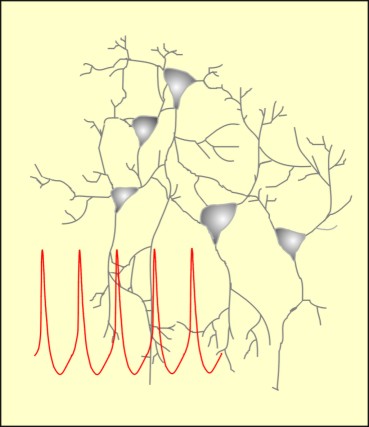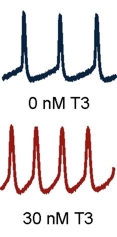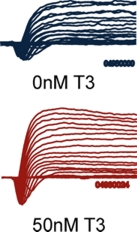|
|

|
 |
AG Dietzel-Meyer
Elektrobiochemistry of neural cells |
|
| |
 |
|
 |
Regulation of Ion channels |
|
| |
|
Regulation of ion channels by thyroid hormone
Neurons keep us in a life-long move, enable us to coordinate our limbs, sit,
stand, think, see, feelů..
Neurons normally do not divide and we use mostly the same neurons troughout
all our life. Neurons can change their connections with each other to a
certain extent, called "synaptic plasticity", which is also considered as
basis for learning.
=>Interestingly, neurons not only differ in their connections, they also
respond to stimuli with to some extent cell type-specific action potential
waveforms. We are interested to find out, whether individual neurons signal
throughout all their lifespan in a constant manner, or whether they can change their electrical properties as a response to molecular signals in the environment. In other words, we want to know whether there is additionally a "functional plasticity" of neurons.
Neurons are ensheathed by glial cells (astrocytes, oligodendrocytes)
which are not directly involved in the propagation of information and which
therefore do not generate action potentials. Recent research from other
laboratories has shown that glial cells are influenced by active neurons and
can in turn influence synaptic transmission between neurons. We are
investigating, whether these cells can additionally influence the elementary
properties of neurons, consisting of characteristic patterns of action
potential responses. Furthermore, we are investigating how the basic electrical
properties of the satellite cells are modified by signals from the environment.
In earlier investigations we have shown that specific ion current
patterns (e.g. different ratios of Na+, K+ and Ca2+ currents in different
cell types) can be found in embryonic neurons already prior to the first signs
of morphological differentiation and contact with target tissue (1;2). In spite
of this early direction to a specific neuronal subtype there is also evidence for
a role of additional environmental factors, such as contact with satellite cells,
hormones or growth factors, in regulating the expression of ion channels and
thus the electrical properties of neurons.
References
|
| |
|
Thyroid hormone action on Na+-currents |
|
| |
|
Regulation of ion channels in oligodendrocyte precursor cells |
|
|
A lack of thyroid hormone leads to a characteristic slowing of speech,
movements and perception as well as to slowed nerve conduction velocities.
Using patch-clamp recordings in the whole cell configuration we demonstrated
that the biologically active thyroid hormone 3,5,3'-triiodo-L-thyronine (T3)
causes an upregulation of the Na+-current density with respect to the K+
current density in membranes of cultured hippocampal neurons from postnatal
rats (3). This upregulation, which also occurs in
cortical neurons, is accompanied by larger action potential amplitudes,
faster charging of the membrane capacitance as well as increased action
potential frequencies as compared with those from cells maintained under
T3-free conditions (4). Apart from a reduction in
myelination the slowing of neuronal function occuring in hypothyroidism
could thus result as well from a reduction in Na+ currents.
Further observations indicate that thyroid hormone does not regulate Na+
currents in neurons directly but rather via a soluble factor released out
of glial cells (5).
 
Action potentials (left) and original current traces(right) of control and thyroid hormone treated cells
Abstract (Englisch) ╗ |
Oligodendrocytes form the insulator sheets of
neurons in the cental nervous system thus enabling the fast transmission of
informations along extended distances. If these cells are impaired during
development nerve pulses no longer reach their distant targets appropriately,
leading to cerbral palsy, which can occur as a consequence of premature birth.
We use a cell culture model to investigate direct effects of potential noxious
and protective factors on purified oligodendrocyte precursor cells. Using this
model we showed that the cytokines tumor necrosis factor-a and interferone -g,
that are released from activated astrocytes or macrophages in response to
inflammation or ischemia, "freeze" impaired oligodendrocyte precursors in an
immature stage (6). Furthermore, we have obtained evidence t
hat a simultaneous treatment with corticosteroids can protect the immature cells
(7). The exposure with deleterious and protective factors
influences the membrane expression of ion currents in the maturing oligodendrocytes
(8).
This project is a cooperation with R. Berger
(former: Knappschaftskrankenhaus Bochum) and the Department of Molecular Biochemistry.

Staining of a mature Oligodendrocyte.
|
|
| |
|
|
